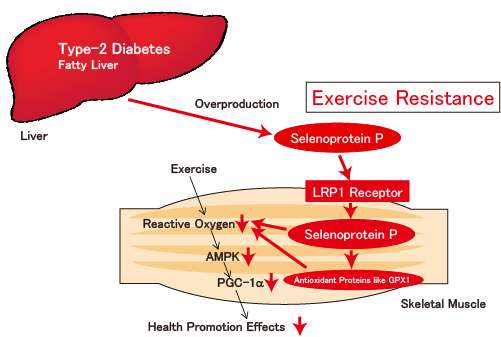Why does the same exercise exert effects on individuals differently?

Selenoprotein P, a kind of hepatokine hormone secreted from the liver, has been found to cause so-called 'exercise resistance,' which prevents physical exercise. Research results now reveal this as one of the reasons that individual responsiveness to exercise differs markedly and could lead to therapy for lifestyle diseases due to lack of exercise, obesity and type 2 diabetes.
In Japan, an increasing number of people suffer from lifestyle diseases like metabolic syndromes, type 2 diabetes and hypertension. Regular physical exercise is recommended for prevention and therapy of these diseases. However, individual responsiveness to exercise is known to differ markedly. Some people derive little benefit from the health promoting effects of regular exercise. The researchers of Kanazawa University reported high blood concentrations of selenoprotein P in in type 2 diabetes patients. The researchers report that selenoprotein P augments insulin resistance to induce elevation of blood glucose levels. However, the effects of selenoprotein P on physical exercise were unclear.
The research team investigated the effects of selenoprotein P on physical exercise with mice and cultured muscle cells and by clinical studies. Mice were subjected to exercise training on a treadmill for 30 minutes per day for one month. The team found that after the one month, the selenoprotein P-deficient mice had 50 percent higher exercise capacity than the wild type (WT) mice.
After the training, the selenoprotein P-deficient mice also showed larger reduction in the blood glucose level upon insulin injection than the WT mice.
WT mice administered with selenoprotein P exhibited reduced level of AMPK phosphorylation, which is related to a variety of favorable training effects. Furthermore, it was shown that the mice deficient of LRP1, the receptor of selenoprotein P in muscles, did not incorporate it into muscle tissues, and that AMPK phosphorylation was unaffected.
Thirty-one healthy but sedentary women without obesity or type 2 diabetes underwent aerobic training for eight weeks, and maximal oxygen consumption was measured as exercise capacity. In general, maximal oxygen consumption was elevated after the training; however, women with high levels of selenoprotein P in the blood before the training did not show much elevation.
These results demonstrate that selenoprotein P causes exercise resistance by affecting muscles through the receptor LRP1, hence cancelling the effects of exercise.
Selenoprotein P levels in the blood are high in patients with type 2 diabetes or fatty liver and in elderly people. There is a possibility that those patients and persons suffering from exercise resistance derive limited benefits from physical exercise.
The results of the present research are expected to lead to discovery of drugs to promote exercise effects by reducing selenoprotein P production in the liver. It is also expected that patients could be diagnosed as exercise-effective or exercise-ineffective by measuring selenoprotein P level in the blood.
More information: Hirofumi Misu et al, Deficiency of the hepatokine selenoprotein P increases responsiveness to exercise in mice through upregulation of reactive oxygen species and AMP-activated protein kinase in muscle, Nature Medicine (2017). DOI: 10.1038/nm.4295




















